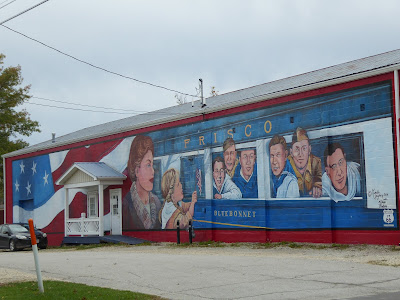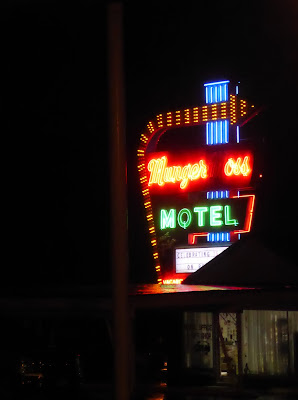We entered our second state via “City 66” in St. Louis. Route 66 wends its way westward through neighborhoods that were probably thriving when the route was new, but show clear signs of decay now. (This would happen in lots of communities along the Route.) There were also about a million stop signs. For this reason, St. Louis was the one place we chose to briefly jump off Route 66 and onto the interstate to leave the city. There are points where travelers on Route 66 are forced onto the interstate, for a mile or several miles—this is what’s meant by 85% (not 100%) of the Route being still drivable today. But otherwise, we avoided the interstate, and indeed tried the oldest alignments whenever possible.
There was another reason for our hurrying out of St. Louis (after a night spent in the walkable Central West End). We were meeting friend of the blog, Dr. Roy Lawson, at the National Museum of Transportation in the western suburb of Kirkwood. First, we did take Route 66 far enough to get some legendary “donuts” on Chippewa Avenue. (Jane, as we affectionately call the British voice of our navigation, pronounced it “Chip-PE-wa.”)
The Lawsons have settled down (for now!) in Missouri, and I wanted to go to this museum, chiefly because it features a preserved court of the sadly demolished Coral Court Motel (1941).
 |
| Photo by Robert Cohen, St. Louis Post-Dispatch |
The Coral Court in Marlborough, nearby, was a premier motor court of its time, but unlike some of the classic motels from Route 66’s heyday, it was not preserved. It featured glass block, like other buildings of Streamline Moderne or Art Deco design. Readers will already have figured out that I love these types of buildings, even though I really don’t know about architecture.
Little did we know how enthusiastically Roy would embrace the opportunity to take us to this museum! You see, they have trains. Rows and rows of trains. I did not even know there was so much to know about trains.
One thing I learned, and had always wondered about, was why passenger train service in the U.S. basically collapsed. When my parents were growing up, the train was still a normal way to travel, and Route 66 follows the railroad through much of the country. A reminder that there was a road there before the Mother Road. Well, it turns out passenger service thrived as long as the mail trains ran. When the postal service started using road and air transportation instead, there was not enough money from passenger fares to support the service. All Americans have now is Amtrak.
 |
| Note hook to scoop up sacks of mail en route. |
After bidding a fond farewell to our old friend (and that is not an ageist remark), we took post-1932 Route 66 as far as Eureka. Then I navigated north on another highway to pick up the scenic western portion of the pre-’32 Route.
 |
| The pre-1932 Route leads to Gray Summit, with one of many "ghost signs" of now-closed businesses. |
What were we starting to notice on our trip? Hiring signs, for one. Every restaurant, shop, business that has made it through the pandemic, in every city or town we’ve been to, is “Now Hiring.” Another thing I notice everywhere is the “P.O.W. – M.I.A.” flag, for members of the armed forces missing in action or who were made prisoners of war.
By the time we reached this tempting water tower,
we were ready for lunch.
Luckily, the Town Tavern is still in business, and has been continuously since 1933. That’s what the young woman running the tavern told us, and she should know, because running it has been her dream ever since she got her first job there.
“One week before COVID” they bought it, and then they had to close. Fortunately for the business, the lockdown forced by the pandemic only lasted one month, “because,” she laughed, “this is a hillbilly county.” Anyway, they made it and now claim to have “the best damn BBQ sauce,” which of course T. had to try. The proprietor even gave us homemade chocolate chip cookies in a Ziploc bag. They were good, too. They kind of reminded me of the “bakies” my friend Fritz used to make. Probably the flavor of smoke imparted by his cigarettes, like those being smoked by this woman and the other customers in her bar.
I loved stepping into her world. I love that someone in little Bourbon is living her dream. I like it that she can make fun of her hometown, even though she’s clearly happy there.
Back on the road, original concrete curbs were sometimes visible along Route 66.
Many towns along the way try to claim attention from the roadside. One that tries especially hard is Cuba, Missouri, originally named for those who fought for Cuban independence from Spain. The town features murals, like this one of soldiers setting off for war aboard the Frisco. Trains again.
Fanning claims to have the world’s second largest rocking chair. There is something poignant about the world’s second largest. We’d paused for a look when the woman at the gift shop came running out and offered to take our picture.
Another thing we kept seeing along Route 66 were truss bridges. Trusses, structured of triangular elements and bearing the load of the bridge, were the height of bridge design in the 1920s and ’30s. Many of these bridges are now considered unsound or have been demolished in the name of progress, but this 1923 example, over the Big Piney River, was simply bypassed by the four-lane.
We drove over it to Devil’s Elbow.
I started noting interesting juxtapositions out the window. One of a thousand Meramec Caverns billboards depicting a “CAVEMAN”! alongside another for the loser of the 2020 presidential election. Then the smell of roadkill, which turned out to be a skunk, followed immediately by the road sign: “Bouquet Road.”
It was another beautiful day and we’d been enjoying the sun roof, kind of a throwback feature of our otherwise modern rental car. Interstate speeds are too fast to open a sun roof. It only started raining just as we reached Lebanon, Missouri, our destination for the night.
And here is where we met Mrs. L. With her husband (recently deceased, as she told me) she bought the Munger Moss (1946) from its original owners, and this year is her 50th running the motel. When we got in, two of her great-grandchildren were playing in the office. She put out her hands to T. as if she were seeing a vision: “They let you out of England? Oh, I have to hug someone from England!”
Mrs. L. hugged each of us, explaining that they’d had no foreign visitors since before COVID, when usually they depend on us. Then she said, “Two beds, I presume.” Well, was I supposed to come out to her? Even my closest family and friends don’t know that T. and I had to be married in order to overcome America’s ban; why should I tell Mrs. L.?
After all, she meant it as the offer of an upgrade. “Room 66,” she said, “because you’re special.” The room was decorated with Route 66 stuff, plus the 1970s furniture that had been new when they bought the place.
I spent a lot of time in the office with Mrs. L. --couldn't help it. COVID had taken away so much, not only her business, but people to talk to. “I just think,” she told me more than once, “that if the government would just get out of everybody’s way.” She thought that everything had started to go wrong when Madalyn Murray O’Hair had sued to stop prayer in schools (I was raised with this belief too). She hated gun violence: what were things coming to, when someone got angry at another member of their family and would just shoot them? So much anger.
That’s what she thought Black Lives Matter was about. Somehow to her “Black Lives Matter” had ceased to be a statement of humanity--because she surely believed black lives do matter--and started to mean a movement, in opposition to other things she believed in. Such as her “We Support Our Local Police” sticker (T. thanked her for this; you don’t see this type of support shown in Britain). And underneath, a smaller, modest sticker in support of the aforementioned former president.
I do not know if, in the days of The Negro Motorist Green Book, the Munger Moss Motel was included as one of the places that would welcome black travelers. In any case, that was before Mrs. L.’s time. I do know that she’d had no one from overseas until a Turkish couple the week before, and boy had she been glad to see them. I saw a lot of memorabilia and it was all we could do to prevent her from giving it to us for free. There was a picture of her, a young woman in 1971, and the original owner with the phone switchboard that was then in use in the motel. She proudly told us that it was now in the Lebanon museum, in the Laclede County Library, which we visited the next morning.
No doubt, there are areas in which Mrs. L. and I would profoundly disagree. Yet I do not believe that she’s stayed in business for so long by mistreating anybody. The Munger Moss Motel is what keeps her going, exactly as it is. She showed us keepsakes from visitors from many other countries; “you’re like my grandma” one young Dutchman had told her.
“I was going to say you remind me of my grandma,” I said. (I should have said “Mam-ma.” She would have known that name.) “But I didn’t want to offend you.”
“I’m not offended by anything,” she said.
Mrs. L. stayed in my mind for a long time, even after our final round of hugs.











3 comments:
A touching tale of the Munger Moss (or "oss" as the sign proclaims brightly). And congratulations on your marriage. P & G
Beautiful my friend!!
Thank you!
Post a Comment